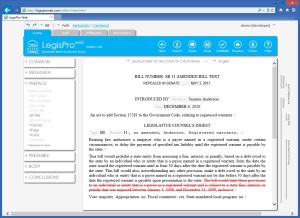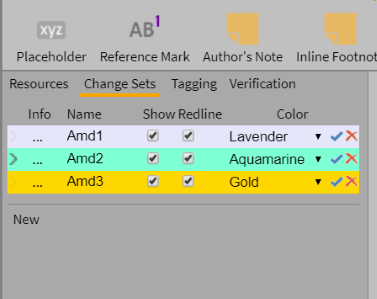It’s been quite a while since I gave an update on our web-based XML legislative editor – LegisProweb. But that doesn’t mean that nothing has been going on. Quite the contrary, this has been a busy year for the editor project.
Let me first recap what the editor is. It’s an XML editor, written entirely around HTML5 technologies. It was first developed last year as the centerpiece to a Hackathon that Ari Hershowitz and I staged in San Francisco and around the world. While it is designed as a general purpose XML editor and can be configured to model any XML schema, it’s primarily configured to support Akoma Ntoso.
Since then, there has been a lot of continuing interest in the editor. If you attended the 2013 Legislative Data and Transparency Conference this past May in Washington DC, you may have noticed Jim Harper of the Cato Institute demonstrating their “Deepbills” project. The editor you saw is a heavily customized early version of LegisProweb, reconfigured to handle the XML format that the US Congress publishes legislation in.
And that’s not the only place where LegisProweb has been adopted. We’re in the finishing stages of a somewhat larger implementation we did for Chile. This is an Akoma Ntoso implementation – focused on debates and debate reports rather than on legislation. One interesting point worth noting – this implementation is done in Spanish. LegisProweb is quite easily localized.
The common thread between these two implementations in the use case – they’re both implementations focused on tagging metadata within pre-existing documents rather than on creating new documents from scratch. This was the focus of the Hackathon we staged back in 2012 – little did we know how much of a market would exist for an editor focused on annotation rather than document creation. And there’s more to still come – we’ve been quite surprised in the level of interest in this particular use-case.
Of course, we’re not satisfied with an editor that can only annotate existing documents. We’ve been hard at work turning the editor into a full-featured legislative editor that works equally well at creating new documents as it does at annotating existing documents. In addition, we’ve made the editor very customizalble as well as adding capabilities to manage the comments and discussions that might revolve around a document as it is being created and annotated.
Most recently, the editor has been upgraded to the latest version of Akoma Ntoso coming out of the OASIS legal document ML technical committee where I am an active member. Along with that effort, the validator has been separated to run as a standalone Akoma Ntoso validator. I talked about that in my blog last week. I’m busy using the validator as I work frantically to complete an Akoma Ntoso project I am working on this week. I’ll talk some more about this project next week.
So where do we go from here? Well, the first big effort is to modularize the technologies found within the editor. We now have a diverse set of customers right now and they can all benefit from the various bits and pieces that make up LegisProweb. By modularizing the pieces, we’ll be able to pick and choose which parts we use when and how. Separating out the validator was the first step. We’ll also be pulling out the reference resolver, attaching it to a native XML database, and partitioning out the client-side to allow the editing component to be used without the full editing environment offered by LegisProweb.
One challenge that remains is handling redlining – managing insertions and deletions. This is a very difficult subject – and one I tackled in the work I did implementing the XML editor used by the California legislature. I took a very different approach in trying to solve the problem with LegisProweb, but I’m not happy with the result. So, I’ll be returning to the proven approach we used way back when we built the original LegisPro editor on XMetaL.
As you can tell, we’ve got our work for the next year cut out for us.



